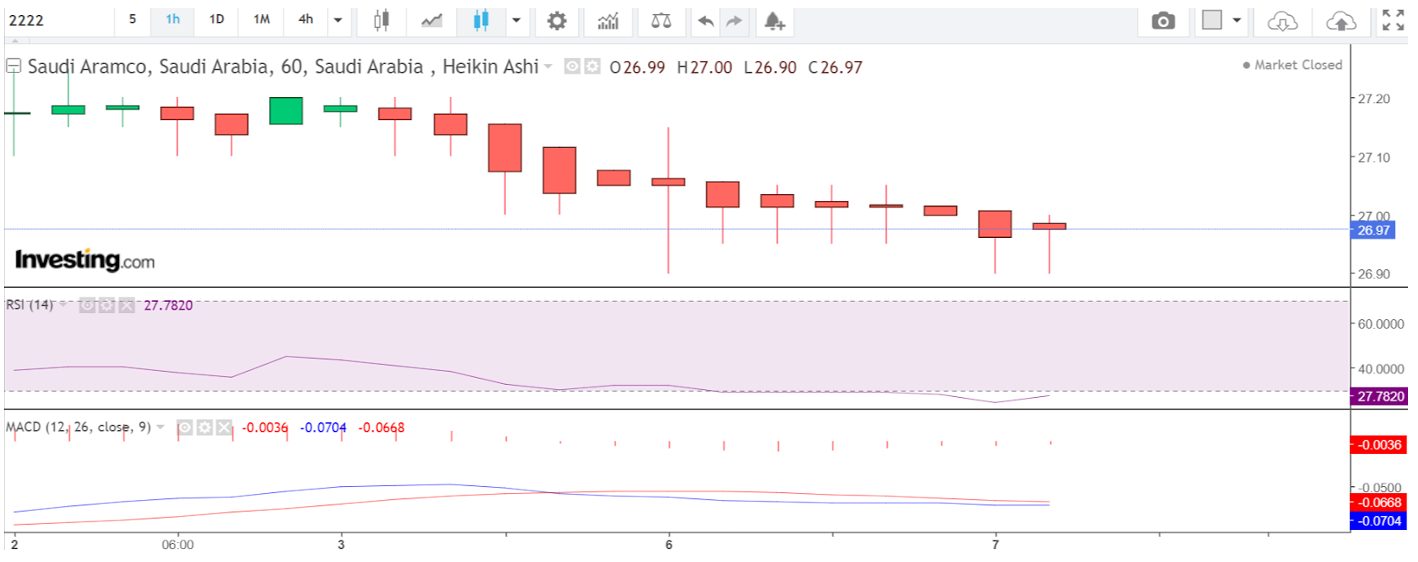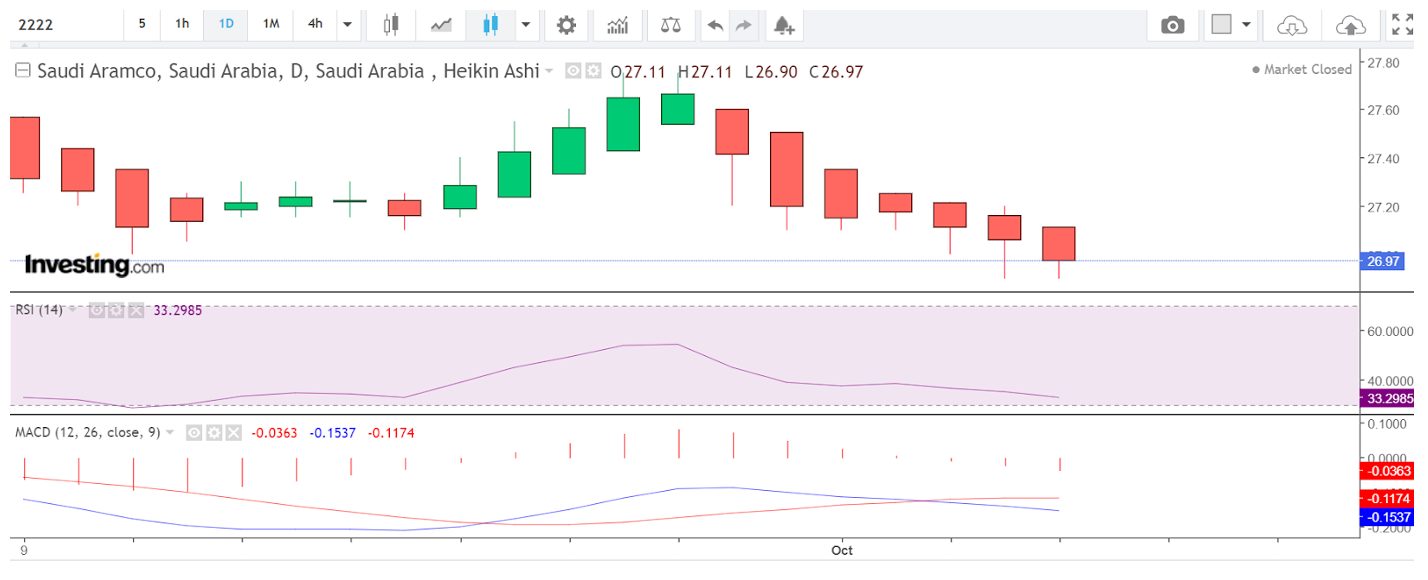CFD Trading in Saudi Arabia



Do you want to speculate on upward and downward price movements of Saudi stocks like Aramco, or global financial markets, without owning the asset? If so, contracts for difference (CFDs) could meet your needs.
With Saudi Arabia (KSA) gradually opening up its financial markets, retail investors are increasingly interested in CFD trading, enticed by their flexibility, with leverage allowing you to amplify results with a modest investment.
Do you want to start CFD trading in Saudi Arabia? Our beginner’s guide has you covered.
Quick Introduction
- You can use CFDs to trade Saudi, other Middle Eastern, and global markets spanning various assets, from stocks and indices to currencies, commodities and crypto.
- CFDs are traded on margin, meaning you only need to deposit a fraction of the total trade value. This leverage amplifies both potential profits and risks.
- CFD trading in Saudi Arabia is regulated by the Capital Market Authority (CMA), which protects retail investors through rules around market transparency and conduct.
- Some CFD providers offer swap-free accounts, aligning with Sharia principles to avoid overnight interest. You can also avoid interest by opening and closing positions the same day
Best CFD Brokers in Saudi Arabia
After direct tests and analysis, these 4 providers are our frontrunners for CFD traders in Saudi Arabia:
How Does CFD Trading Work?
CFDs offer opportunities to trade Saudi Arabian and global financial markets without the added capital investment needed to own the actual asset.
Rather than commit the total capital to buy assets outright, you predict whether the price will increase or decrease and only commit enough capital necessary to execute the trade.
Leverage is one of the most attractive elements of CFD trading. It allows you to open significant positions while committing a fraction of the total value or margin.
Here’s how it works…
Let’s say you’re looking to trade the leading stock index in KSA, the Tadawul All Share Index (TASI).
You enter a CFD buy position if you believe the TASI will rise. Each contract is valued at Saudi riyal (SAR) 12,000, and your brokerage requires a 5% margin. To take a position on 10 contracts, your margin requirement would be 6,000 (12,000 per contract x 10 contracts x 5%).
If the TASI rises to 12,100, the price increase would yield SAR 1,000 per contract. By closing your position, you would realize a profit of SAR 10,000 (10 contracts x SAR 1,000), excluding any brokerage fees.
However, if the index falls to SAR 11,900, you would lose SAR 10,000, illustrating the risks associated with CFD trading; the potential losses are also magnified.
Understanding the margin requirements and potential risks of CFDs is vital.A demo account is ideal for practising trading strategies and building awareness before risking real Saudi riyals in live markets.
What Can I Trade?
Trading CFDs provides many opportunities across different financial markets, both in KSA and internationally:
- Stock CFDs – You can speculate on individual company stocks quoted on the Saudi Stock Exchange, such as Aramco, Batic Investments and Logistics, and Anaam Group. These highly liquid firms can be traded as CFDs without committing the capital needed to purchase the actual shares.
- Index CFDs – The Tadawul All-Share Index (TASI) is the official price index of the Saudi Stock Exchange. It is a price index in which all stock corporations on the Tadawul Stock Exchange are listed. It reflects the development and market capitalization of the entire Saudi Arabian stock market. Traders often choose index CFDs to capitalize on the domestic market’s overall performance rather than trade individual shares. Alternatively, you could explore index CFDs on global indices like the Dow Jones or the NASDAQ.
- Forex CFDs – The SAR is traded in the foreign exchange market; currency pairs to trade as CFDs include USD/SAR and EUR/SAR, although these pairs lack the liquidity and opportunities for short-term traders compared to major pairs like EUR/USD and USD/JPY.
- Commodity CFDs – You could speculate on oil, given Saudi Arabia’s position as one of the world’s largest producers, or natural gas given the country’s efforts to diversify its energy landscape.
- Crypto CFDs – In KSA, there is curiosity and excitement surrounding digital asset trading. You trade cryptocurrency CFDs like Bitcoin and Ethereum for access to the highly volatile world of crypto.
Is CFD Trading Legal In Saudi Arabia?
CFD trading is legal in Saudi Arabia but subject to regulations enforced by the Capital Market Authority (CMA), the country’s primary regulatory body for financial markets.
The CMA ensures that all financial trading activities are conducted fairly, transparently, and in a manner that protects investors.
You are encouraged to trade CFDs through brokers regulated by recognized authorities, whether locally by the CMA or internationally (e.g., FCA, ASIC).
Due to leverage, CFD trading is considered high-risk, and providers should disclose the associated risks clearly to traders.
Since Saudi Arabia is a predominantly Islamic country, for many residents, financial activities must align with Islamic finance principles (Sharia law). In CFD trading, this primarily affects interest-related issues, such as overnight swaps.Fortunately, many firms offer Islamic (swap-free) accounts structured to avoid interest charges and align with Sharia law, making them halal for Muslim traders.
You can also avoid overnight interest charges by opening and closing within the same day.
Is CFD Trading Taxed In Saudi Arabia?
In Saudi Arabia, there is no personal income tax on individuals, including income derived from trading activities like CFD.
Saudi Arabia also does not impose a capital gains tax on individuals, meaning that profits from short-term CFD trading are typically not taxed.
However, the situation may differ if you trade CFDs through a corporate structure (such as a business or investment firm). Corporate entities in Saudi Arabia are subject to a 20% corporate income tax on their taxable income, which could include trading profits.
Saudi Arabian nationals and citizens are subject to Zakat, an Islamic wealth tax. Zakat is calculated on wealth and assets, typically at a rate of 2.5%.
If you are a Saudi citizen and your trading profits contribute significantly to your wealth, they may be considered part of your Zakatable assets.
Expatriates are not subject to Zakat but may fall under different regulations for their home countries.
An Example Trade
We’ve covered the theory, but let’s show you how a CFD trade in Saudi Arabia could unfold.
Background
For this CFD trade, I’m looking at the Saudi Arabian Oil Company (ARAMCO), which operates as an integrated energy and chemical company in Saudi Arabia and internationally. It is the second-largest company in the world in terms of revenue and is headquartered in Dhahran.
Saudi Aramco has the world’s second-largest proven crude oil reserves, at more than 270 billion barrels (43 billion cubic metres) and the most significant daily oil production of all oil-producing companies.
Fundamentals
When I was making the trade, Saudi Aramco’s market cap was $1.739 trillion, making it the sixth most valuable company in the world by market cap.
When looking to day trade a CFD, you don’t necessarily enter the same depth of analysis that a buy-and-hold investor does because you don’t have that luxury of time. You can employ stock screening apps to alert you to suddenly active shares or set an alert for undervalued or overbought shares.
You can always gain significant insight into a quoted company’s financial position by using freely available data from various sites such as Google Finance, Yahoo Finance, and Investing.com.
Looking at some key metrics for the ARAMCO share’s performance:
- The P/E ratio was 15.46
- The gross profit margin was 56.5%
- The 52W range was between 26.08 and 34.05
- The 1YR fall was 19.38%
- The EPS earnings per share was 1.8
These relatively healthy metrics have encouraged me to discover if the stock (trading at a multi-year-low) was oversold.
Technical Analysis
It’s sensible to measure technical analysis on at least two timeframes. Even if you’re eager to make a trading decision, a detailed examination of two charts can be managed.
Consider a lower timeframe (TF) like the 1-HR (1-hour) and a higher timeframe like the D1 (daily). That way, you’re getting the short-term trading session view and can see if there’s any medium-term support for your decision.
Limiting the technical indicators on your chart is also prudent, as overthinking can lead to analysis paralysis. I suggest trying to select no more than four, one from each of these critical groups: trend, momentum, volatility, and volume.
The RSI and MACD, combined with a candlestick formation to illustrate the price action, should (in theory) cover all of your bases.
This example uses the smoothed Heikin Ashi (HA) candlestick option.
1-HR Timeframe
As you can see below, on the 1-HR TF, the moving averages on the MACD have narrowed and are close to convergence and crossover. The histogram bar is also close to printing a bullish reading. The RSI is at 27.78, which (below 30) suggests the stock is oversold.
The HA candlestick formation in the session shows that the price is making higher lows. The most recent 1-HR candle is a hammer, suggesting that a balance between buyers and sellers is developing.

D1 Timeframe
The price action illustrated on the D1 timeframe below, where price printed higher lows, suggests the downward bearish momentum is exhausted.
With a reading of 33.29, the RSI is close to the oversold area of 30. Overall, the D1 chart doesn’t provide conclusive proof that the stock is ready to turn from bearish to bullish; however, I see enough (across both charts) to encourage me to take a long position.

My order ticket contained the following orders:
- Entry order: 27.00
- Stop loss order: 26.00
- Profit limit order 28.00.
Using a CFD, I’m trading 100 units at $27.00. Because I’m using 1:5 leverage, I only need to commit a 20% margin of the overall cost to take the trade. Instead of spending $2,700 on 100 shares, the position requires me to put up $540.I typically only risk 1% of my account size per trade; my stop loss (at 26.00) represents a fresh yearly low.
Bottom Line
CFD trading is legal and not taxed for individual traders in Saudi Arabia. To align with Islamic finance principles, traders must use regulated brokers, ideally those offering Sharia-compliant (swap-free) accounts.
As always, it’s essential to trade responsibly and be aware of the risks associated with CFD trading – never risk more riyals than you can afford to lose.
To get moving, utilize DayTrading.com’s choice of the top platforms for day trading CFDs.
Recommended Reading
Article Sources
- Capital Market Authority (CMA)
- Sharia Principles - Charles Stanley
- Tadawul All Share Index (TASI)
- Aramco
- Batic Investments and Logistics
- Anaam Group
- Zakat - Investopedia
- Stock Screening Apps - Yahoo Finance
- Investing.com
- Google Finance
The writing and editorial team at DayTrading.com use credible sources to support their work. These include government agencies, white papers, research institutes, and engagement with industry professionals. Content is written free from bias and is fact-checked where appropriate. Learn more about why you can trust DayTrading.com



